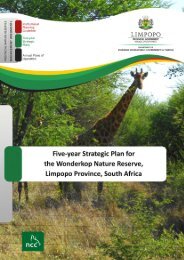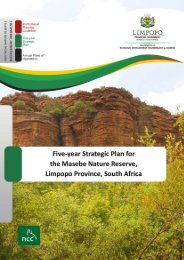Guiding principles for reserve management - NCC Environmental ...
Guiding principles for reserve management - NCC Environmental ...
Guiding principles for reserve management - NCC Environmental ...
- No tags were found...
Create successful ePaper yourself
Turn your PDF publications into a flip-book with our unique Google optimized e-Paper software.
2.4.7 Fauna2.4.7.1 MammalsDuring the latest aerial survey undertaken in 2012, 295 head of game was counted. This is only threemore than the total of 292 that was recorded in the LNR in 2012, which means that there has not beenmuch recruitment of game over a two year period and may point to high poaching or other externalfactors influencing the recruitment of wildlife populations. The following mammal species wererecorded in the <strong>reserve</strong> in 2012: Burchell’s Zebra, Mountain Reedbuck, Warthog and Waterbuck(grazers); Bushbuck and Klipspringer (browsers); Common Duiker and Eland (mixed feeders); as well asChacma Baboon and Black-backed Jackal (other feeders). Relatively large numbers of cattle, donkeys,goats and humans were also recorded in the <strong>reserve</strong> boundaries during both of these aerial surveys: 1686 head of cattle was counted during the 2010 survey, which is significantly more than the totalnumber of game recorded within the <strong>reserve</strong>, and in 2012 286 head of cattle was recorded.In addition to the mammal species listed above, Leopard, Brown Hyaena and Samango Monkey are alsoknown to occur within the <strong>reserve</strong>. Some of the smaller mammal species known to occur in LNR are:Cape Clawless Otter, Water Mongoose, Side-striped Jackal, Red Duiker, Caracal, African Civet, AfricanWild Cat, Yellow Spotted Rock Hyrax, Serval, Honey Badger, Klipspringer, Aardwolf and a number of batsand rodents, amongst others. A complete mammal species list <strong>for</strong> the LNR is included in the <strong>reserve</strong>State of Knowledge Data Repository (SOKDR).2.4.7.1.1 Mammal Species of Conservation ConcernThe mammal species of conservation concern listed in Table 5 are known to occur in the LNR.Table 5: Mammal species of conservation concern known to occur in the Legalameetse Nature ReserveSCIENTIFIC NAME COMMON NAME IUCN STATUSPanthera pardus Leopard Near threatened.Cercopithecus albogularis Samango Monkey Least concern, but habitatdependant.Dendrohyrax arboreus Eastern Tree hyrax Least concern, but locally rare.Hyaena brunnea Brown Hyaena Vulnerable.2.4.7.2 AvifaunaThe LNR is part of the Wolkberg Forest belt, well known <strong>for</strong> its avifaunal diversity and has beenidentified as a Global Important Birding Area (IBA No. 005). The landscape is characterised bynumerous cliff lines, peaks, kloofs and <strong>for</strong>ested gorges, whilst the diverse vegetation types present arecomprised of six different vegetation units. The heterogeneity and diversity within the landscape andvegetation allow the LNR to host a wide range of grassland, woodland, <strong>for</strong>est and cliff-nesting avianspecies. The presence of eight perennial rivers, including the Selati, Makhutse and a number oftributaries of the Ngwabitsi Rivers, offers numerous habitat types <strong>for</strong> various waterfowl andriparian/wetland associated species.There are currently 39 verified avian species, of which 21 occur on the IUCN Red List of ThreatenedSpecies, occurring at the LNR, namely African Crowned Eagle (Near-threatened), African Finfoot(Vulnerable), Ayres’s Hawk-eagle (Near-threatened), Bat Hawk (Near-threatened), Black Stork (Nearthreatened),Bateleur (Vulnerable), Black-bellied Bustard (Near-threatened), Broad-tailed Warbler(Near-threatened), Cape Parrot (Endangered), Cape Vulture (Vulnerable), Half-collared Kingfisher (Nearthreatened),Denham’s Bustard (Neat-threatened), Lanner Falcon (Near-threatened), Lesser KestrelReserve Management Documents: Legalameetse Nature Reserve (Strategic Plan) 23

















